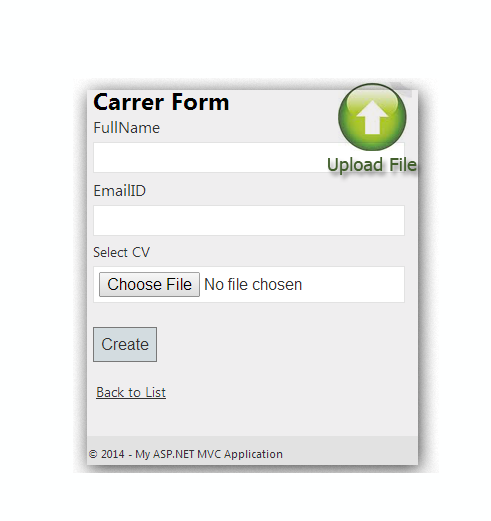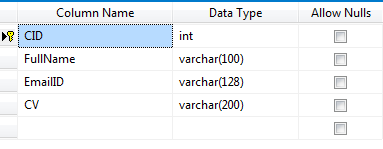Introduction
This is the 3rd part of this series, where I am going to explain how to create career page with upload file (CV) in MVCYou know, Dotnet awesome is a platform to learn, read and explore contents related to web development. Here in this series "Implement basic functionality in asp.net MVC application", I have explained how to create some very basic functionality like create a registration page, login page, file upload page etc., especially for beginners.
I have explained following articles in the series "Implement basic functionality in asp.net MVC application"
- How to create a User Registration page using asp.net mvc
- How to create a login page using asp.net mvc
- How to create career page with Upload file (CV) in MVC
- How to create Feedback page with cascade dropdownlist in MVC.
- How to display database data in webgrid in mvc
Steps :
Step - 1: Create New Project.
Go to File > New > Project > Select asp.net MVC4 web application > Entry Application Name > Click OK > Select Internet Application > Select view engine Razor > OKStep-2: Add a Database.
Go to Solution Explorer > Right Click on App_Data folder > Add > New item > Select SQL Server Database Under Data > Enter Database name > Add.Step-3: Create table for Save data.
Open Database > Right Click on Table > Add New Table > Add Columns > Save > Enter table name > Ok.In this example, I have used one tables as below
Step-4: Add Entity Data Model.
Go to Solution Explorer > Right Click on Project name form Solution Explorer > Add > New item > Select ADO.net Entity Data Model under data > Enter model name > Add.A popup window will come (Entity Data Model Wizard) > Select Generate from database > Next >
Chose your data connection > select your database > next > Select tables > enter Model Namespace > Finish.
Step-5: Apply validation on model.
Open your model and add validation. Please follow below codenamespace MVCCarrer
{
using System;
using System.Collections.Generic;
using System.ComponentModel.DataAnnotations;
public partial class Carrer
{
public int CID { get; set; }
[Required(ErrorMessage="Please provide fullname", AllowEmptyStrings=false)]
public string FullName { get; set; }
public string EmailID { get; set; }
public string CV { get; set; }
}
}
Step-6: Create a Controller.
Go to Solution Explorer > Right Click on Controllers folder form Solution Explorer > Add > Controller > Enter Controller name > Select Templete "empty MVC Controller"> Add.Here I have created a controller "CarrerController"
Step-7: Add new action into your controller for Get Method
Here I have added "SubmitCV" Action into "Carrer" Controller. Please write this following codenamespace MVCCarrer.Controllers
{
public class CarrerController : Controller
{
public ActionResult SubmitCV()
{
return View();
}
}
}
Step-8: Add view for your Action & design for create form.
Right Click on Action Method (here right click on SubmitCV action) > Add View... > Enter View Name > Select View Engine (Razor) > Check "Create a strong-typed view" > Select your model class > Add.HTML Code
@model MVCCarrer.Carrer
@{
ViewBag.Title = "SubmitCV";
}
<h2>SubmitCV</h2>
@using (Html.BeginForm("SubmitCV", "Carrer", FormMethod.Post, new { enctype="multipart/form-data"}))
{
@Html.ValidationSummary(true)
@Html.AntiForgeryToken()
@* This AntiForgeryTokey is used for prevent CSRF Attack*@
<fieldset>
<legend>Carrer</legend>
@if (ViewBag.Message != null)
{
<span style="color:green">
@ViewBag.Message
</span>
}
<div class="editor-label">
@Html.LabelFor(model => model.FullName)
</div>
<div class="editor-field">
@Html.EditorFor(model => model.FullName)
@Html.ValidationMessageFor(model => model.FullName)
</div>
<div class="editor-label">
@Html.LabelFor(model => model.EmailID)
</div>
<div class="editor-field">
@Html.EditorFor(model => model.EmailID)
@Html.ValidationMessageFor(model => model.EmailID)
</div>
<div class="editor-label">
Select CV
</div>
<div class="editor-field">
<input type="file" name="file" />
@Html.ValidationMessage("CustomError")
</div>
<p>
<input type="submit" value="Create" />
</p>
</fieldset>
}
<div>
@Html.ActionLink("Back to List", "Index")
</div>
@section Scripts {
@Scripts.Render("~/bundles/jqueryval")
}
Step-9: Add new Folder to Save CV
Go to Solution Explorer > Right Click on Solution Explorer > Add > New Folder > Enter folder name.Step-10: Add new action into your controller for POST Method
Here I have added "SubmitCV" Action with Model Parameter (here "Carrer") into "Carrer" Controller. Please write this following code[HttpPost]
[ValidateAntiForgeryToken]
public ActionResult SubmitCV(Carrer C, HttpPostedFileBase file)
{
if (file == null)
{
ModelState.AddModelError("CustomError", "Please select CV");
return View();
}
if (!(file.ContentType == "application/vnd.openxmlformats-officedocument.wordprocessingml.document" ||
file.ContentType == "application/pdf"))
{
ModelState.AddModelError("CustomError", "Only .docx and .pdf file allowed");
return View();
}
if (ModelState.IsValid)
{
try
{
string fileName = Guid.NewGuid() + Path.GetExtension(file.FileName);
file.SaveAs(Path.Combine(Server.MapPath("~/UploadedCV"), fileName));
using (MyDatabaseEntities dc = new MyDatabaseEntities())
{
C.CV = fileName;
dc.Carrers.Add(C);
dc.SaveChanges();
}
ModelState.Clear();
C = null;
ViewBag.Message = "Successfully Done";
}
catch (Exception ex)
{
ViewBag.Message = "Error! Please try again";
return View();
}
}
return View();
}
Step-11: Run Application.
If you are using jquery in your application and you want to implement upload file asynchronously, you should take a look on this article how to upload files asynchronously using ASP.NET MVC4



